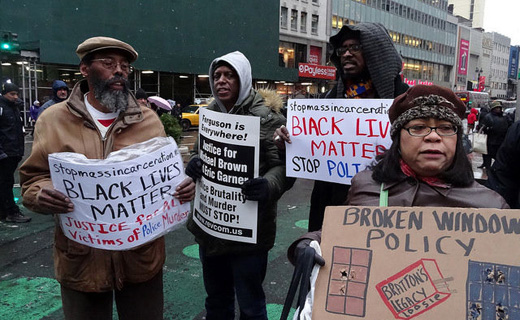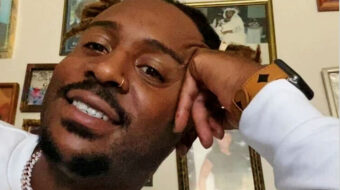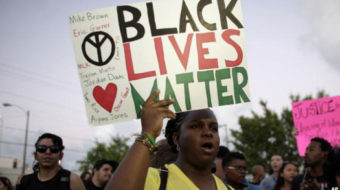
Ed. note: This article is the second in a series on Black Lives Matter and capitalism. Click here to read the previous article.
As the nation continues to deal with the aftermath of the police murders of two Black men, Alton Sterling and Philando Castile, along with the five officers shot and killed in Dallas, Texas, just days after, we are faced with America’s ever-present problem of racial oppression.
We saw in the first article in this series that the lasting history of chattel slavery, the creation of Jim Crow segregation, and the new Jim Crow of the Prison Industrial Complex all emerged under a system that depends heavily on exploitation of African-American labor for profit.
How then do movements for Black liberation and racial equality combat such systemic oppression? Recent movements such as Black Lives Matter have been grappling with this question as the various groups underneath the unifying slogan put forth a comprehensive set of demands to combat the police brutality that disproportionately affects African Americans. Yet the struggle that the Black Lives Matter movement has brought to the fore is not a new one.
Since the birth of this nation, brought about through the labor of enslaved Black people, there have been movements to deal with America’s race problem. These movements have changed the political context for government and politicians to act, and they experienced backlash and internecine clashes of perspectives as well. How have collective movements already changed the political context for policies and reforms to be made? How can emerging movements build power to change it further? Since we know the problems we face are not new ones, if we take a look back on history we can see what answers we have discovered in the course of struggle to add to the narrative of change going forward.
From Booker T. Washington to W.E.B. Du Bois
The abolition of slavery at the end of the Civil War ushered in the era of Radical Reconstruction from 1865-1877. It was a time of hope — and of legislative gains. But the Compromise of 1877 sabotaged Radical Reconstruction and left the Black community unprotected by law from the aggression of the descendants of slaveholders and the domestic terrorist organizations they formed, such as the Ku Klux Klan. Racial tensions were high all across the country, as Jim Crow segregation began to take hold. Black Americans were left with the question of where they fit into the structure of the United States — and what was needed for advancement.
Educator, author, and occasional presidential advisor, African American Booker T. Washington, dominated the debates in the late 1800s through the early 1900s. Washington’s idea was that in order to maintain racial peace, and prosperity for African Americans, Black people needed to learn skills that the world (white people) found valuable. There was an emphasis on the importance of acquiring land, homes, vocations and skills, along with obeying the law and cooperating with white authorities to maintain peace. Washington believed that entrepreneurship and industrial education would lead to prosperity for Black America rather than directly challenging the laws of Jim Crow segregation.
In his famous speech entitled “The Atlanta Compromise,” Washington stated:
“The wisest among my race understand that the agitation of questions of social equality is the extremest folly, and that progress in the enjoyment of all the privileges that will come to us must be the result of severe and constant struggle rather than of artificial forcing… The opportunity to earn a dollar in a factory just now is worth infinitely more than the opportunity to spend a dollar in an opera-house.”
Yet some disagreed with Washington’s viewpoint that Blacks could only gain prosperity through economic means. A leading opponent of Washington’s view was historian, sociologist, and early civil rights activist W.E.B. Du Bois.
Du Bois explained that Washington’s solutions were too narrow and limited to economic objectives. In one of his most famous writings, The Souls of Black Folk, Du Bois accused Washington of preaching a “gospel of Work and Money to such an extent as apparently almost completely to overshadow the higher aims of life.” Du Bois also argued that Black people had to fight for an increase in political and civil status, for without that, under the modern economic system Black people could not defend their rights (such as to land, businesses, etc.) and would be forced to exist without the vote.
Du Bois was a leader and founder of the Niagara Movement, an early black civil rights organization that openly fought against racial segregation and disenfranchisement. With the Niagara Movement’s Declaration of Principles, of which Du Bois was a co-author, it became the first African American organization to demand racial equality in all aspects of life. When the Niagara Movement disbanded in 1908 Du Bois went on to help found the National Association for the Advancement of Colored People (NAACP) which would go on to be a leading force in the Civil Rights Movement. It was clear heading into the mid-20th Century that many in the Black community believed ownership of land and jobs were not enough, and that prosperity had to come about through full recognition of equality and inclusion.
Civil Rights, nonviolence, urban uprisings, and Black Power
Just as the end of chattel slavery in the U.S. brought forth the question of where African Americans fit in society, so too did the end of the “separate but equal” doctrine that dominated the land since 1868. Brown v. Board of Education in 1954 saw a legal end to Jim Crow segregation, bringing about the 1954-1968 era of the Civil Rights Movement. During this time African Americans fought to ensure legal recognition and federal protection of their citizenship rights.
Acts of nonviolence and civil disobedience dominated the strategy of the movement as a means to force a dialogue between activists and government authorities. Campaigns within the movement, such as the successful Montgomery Bus Boycott, which helped put an end to the unconstitutional act of segregation on public transit, helped to keep the issue of racial oppression at the forefront of Americans’ minds. Another victory of this movement was the passing of the Civil Rights Act of 1964 that outlawed discrimination based on race, religion, sex, and national origin.
In his “Letter from Birmingham City Jail,” Martin Luther King Jr. explained that the nonviolent campaign had four basic steps to determine if action needed to be taken:
(1) Collection of the facts to determine whether injustices are alive,
(2) Negotiation,
(3) Self-purification,
(4) Direct action.
While the Civil Rights movement made major gains, it was not enough to stop the unrest felt in many of the cities throughout the country as unemployment in poor inner cities dominated by African Americans was on the rise, along with police harassment. There would be a series of riots starting from 1964 through 1968 including the Harlem riot of 1964, the six-day Watts riot of 1965, the Detroit riot of 1967, and the riots following the assassination of Martin Luther King Jr. in 1968. Although segregation was no longer legal, it seemed to be de facto in the inner cities as white flight left many poor African Americans behind with dilapidated housing, high rates of unemployment, and high tensions with predominantly white police forces. The riots would result in further property devastation in cities, and a number of deaths.
From the midst of these riots emerged the Black Power movement. This was a movement characterized by people frustrated with the nonviolence and integration strategy associated with the Civil Rights movement, who sought more radical tactics to ensure Black liberation. The organization that would become synonymous with the Black Power movement would be the Black Panther Party (BPP).
Launched in Oakland, California, The Black Panthers was a Black-led organization which used armed citizen patrols to challenge police brutality in Black-dominated neighborhoods. The Black Panthers’ program, called the Ten Point Platform, included demands of self-determination for the Black community, livable housing, better education, employment, an end to police brutality in Black communities, and freedom for Black prisoners. The Panthers implemented the successful “Free Breakfast for Children Program” that aimed to provide free meals for Black families in their neighborhoods, while also shining light on the shortcomings of the U.S. government’s so-called War on Poverty. The Black Panther Party would rise in popularity from its inception in 1966 until its decline in the early 1980s.
As the documentary film Black Panther Party: Vanguard of the Revolution showed, the fall of the Panthers was largely orchestrated by the U.S. government, through its Counterintelligence Program known as COINTELPRO, as they were seen as a major threat to the system. It should be noted that COINTELPRO also targeted the Civil Rights Movement. This FBI operation aimed to dismantle the various influential organizations fighting for Black liberation. COINTELPRO organized undercover agents to infiltrate these movements along with carrying out targeted assassinations of Black Panther leaders Fred Hampton and Mark Clark, along with national leader Malcolm X. The Black Panthers was an organization of activists who were part of a long line of activists going against a system bent on continuing the exploitation of Black people.
Yet although the Black Panthers, which was largely a nationalist organization, became synonymous with the emergence of Black Power, their primary work was to courageously fight against segregation and racial oppression. What helped their work be more effective was the work of a massive united multiracial movement, including more mainstream organizations such as the NAACP, that during this time were also fighting for liberation.
New movements, continued struggles – and more work to be done
Through a brief look at the history of movements for Black liberation we have seen that there have been gains made to combat the embedded anti-Black racism within the system. Yet even with the gains made, there is plenty of work that still needs to be done. Continued police violence, a staggering increase of Blacks and Latinos disenfranchised and held captive in the prison industrial complex, and the continued poverty of many African Americans – these show that the old battles are still being fought. The American dream of life, liberty, and the pursuit of happiness continues to be elusive to Black America as a whole. The question remains: Were Black Americans ever meant to be part of the American dream in the first place?
As revolutionary Black leader Malcolm X stated in 1964 in his famous speech The Ballot or the Bullet, “No, I’m not an American. I’m one of 22 million black people who are the victims of Americanism… I’m speaking as a victim of this American system. I don’t see any American dream; I see an American nightmare.”
It is within this “nightmare” that emerging movements have continued to try to find some semblance of hope. Newer movements such as Black Lives Matter (BLM) and Moral Mondays are continuing the tradition of using various strategies of civil disobedience, protests, and publicized demands, to call attention to the racial oppression faced by African Americans in the United States. Through their actions they have won some victories. Yet they have also faced a backlash reminiscent of the criticisms that organizations fighting for Black liberation faced in the past.
With the recent lone gunmen shootings that have resulted in the deaths of some police officers, for instance, there has been an increased push to paint Black Lives Matter as a movement of violence and hate. This is not dissimilar to the rhetoric once used against the Black Panther Party during its early years. As BLM activist Janae Bonsu explained in a July 2016 article in People’s World:
“If history is any prologue, the narrative that is being built… is going to be used to catapult a far-reaching strategy to criminalize the movement for Black lives’ commitment to resistance and accountability. We’ve seen this before in the Civil Rights Movement that coincided with the War on Crime… These measures are nothing more than attempts to censor and criminalize political resistance and protests of police violence. Lawmakers aren’t trying to protect officers; they’re trying to suppress a movement.”
Yet, despite this backlash, organizations under Black Lives Matter have continued to put forth demands and organize demonstrations to bring about an end to police brutality and unjust policing of the African American community. Most recently there has been formulated a united platform entitled A Vision for Black Lives: Policy Demands for Black Power, Freedom, & Justice. In this comprehensive platform, activists touch upon key issues such as economic justice, the fight for reparation, and Black people having control of their own communities. One of the opening lines of the platform summarizes accurately that “Black humanity and dignity requires Black political will and power.”
This platform is a step in the direction of addressing the unfinished work to be done from the time of movements before Black Lives Matter. Like those movements of the early 1900s into the late 1970s, we don’t have a clear idea of what the end result of that work will look like until it is achieved. Despite this uncertainty we have no choice but to work towards something that dismantles this system of oppression and exploitation tied to profit for the wealthy white elite.
As American activist and vice chair of the Communist Party USA Jarvis Tyner stated in his 2016 article Black lives matter! The struggle against police murders, brutality and abuse, “The revolutionary process is not a sprint, but a marathon… The movements that we see today are a continuation of the great battles for freedom that went before. If we win the battle at this stage, the struggle will move to a higher level, embracing more that needs to change.”
Just as the oppression of Black people is baked into the oppressive system we live under, so too is the continued fight for Black liberation intertwined with the shaping of our nation. This fight for liberation has already influenced our laws and culture; it will continue to do so.
Photo: Political Research (CC)









